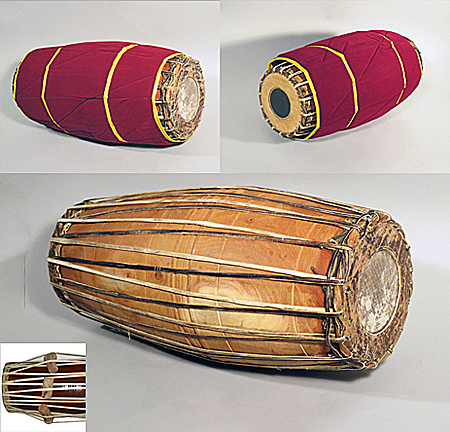
Owner: HWMC
Catalog#: 2AS-MBST-19
Struck Membranophones
India 'Mridangam'
South India
Indian – Carnatic Music
Wood, hide, velvet, cloth, paste
Mid 20th century
Length: 22.5 in, Large diameter: 9 in, Small diameter: 7.5 in
Membranophones – Struck Membranophones
The mridangam (mrdangam), also known as “Deva Vadyam” (instrument of Gods), is a double-headed barrel shape drum used as the primary rhythmic accompaniment in a Carnatic music ensemble. During a percussion ensemble, the mridangam is often accompanied by the ghatam, kanjira, and morsing. (All of these instruments can also be found in this collection for reference.)
This mridangam is made of light sanded and stylized jackfruit wood with thick leather cords holding the double animal skin heads on either end. Both drumheads have a combination of two inhomogeneous circular membranes which allows for the production of unique and distinct harmonics. The larger left-side is used to create bass pitches and is tuned an octave lower than the smaller right-side end. This smaller end also has a black tuning paste on the center known as the satham or karanai and gives the mridangam its distinct metallic timbre. The long leather straps which extend the length of the instrument holding both heads tight are used to tune the instrument as well as small wooden dowels that slip under the lacings for tightening and control of the tension. The body of the drum is stylized with beveled circular carving around the width. The instrument comes with a red velvet cushioned cover with gold ribbon detailing. This cover is sometimes fitted on the drum when played.
The mridangam is played when sitting with the drum held across the lap while using both hands and fingers. Similar to the mridangam is the northern mrdang or pakhavaj (also found in this collection), that is played in the Hindustani classical traditions of northern India, Pakistan and Bangladesh.
